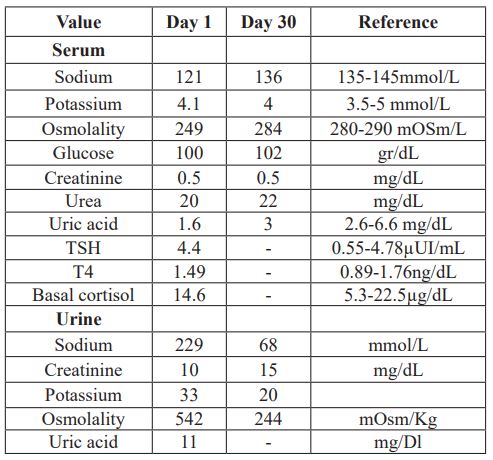The Syndrome of Inappropiate Antidiuresis Related To SARS-COV2 Pneumonia Treated with Tolvaptan
Yanieli Hernández, Cristina Vega-Cabrera*, Begoña Rivas Becerra, Lina María Leon, María Maldonado, Auxiliadora Bajo
Nephrology Service, La Paz University Hospital, Spain
Received Date: 26/11/2021; Published Date: 23/12/2021
*Corresponding author: Cristina Vega-Cabrera, Nephrology Service, La Paz University Hospital, Madrid, Spain
Hyponatremia is the most frequent electrolytic disorder in hospitalized patients [1]. Approximately, 1/3 of all cases of hyponatremia are accounted for by the Syndrome Inappropiate of secretion of antidiuretic hormone (SIADH) [2], and may be secondary to drugs, infections or tumors. Most respiratory infections have been reported to cause SIADH.
We present a case of SIADH related to severe bilateral pneumonia due to SARS-COV2.
CASE
A 62-year-old woman, with no relevant medical history, attended the emergency department with a non-productive cough, fever and dyspnea. Upon admission, she presented bilateral pulmonary infiltrates compatible with SARS-COV2 pneumonia that was confirmed with nasopharyngeal swab proved to be positive in the Polymerase Chain Reaction analysis and was treated with hydroxychloroquine and azithromycin for 5 days according to the protocol of the hospital center.

Figure 1: Computed tomography (CT).
After a few days she presented clinical and radiological worsening with lung CT showing bilateral oppacities in all lobes (Figure 1) requiring orotracheal intubation and mechanical ventilation in the Intensive Care Unit (ICU).
After 20 days in the ICU, she presented a progressive decrease in sodium levels up to 121 mmol/ L associated with drowsiness, dizziness and severe headache. Brain CT was normal. Urine chemistry showed urine sodium of 134 mmol/L,urinary osmolality of 611 mOsm /L, plasma osmolality of 259 mOsm /L, serum uric acid 1.8 mg/dl and a negative clearance of electrolyte-free water (Table 1).
She was euvolemic and did not recieved any diuretic treatment, so SIADH was suspected. Given the severity of her symptoms, treatment with hypertonic (3%NaCl) saline was started inmediately (1 ml / kg / h). Within 24 hours, sodium levels rose to 128 mmol/l with neurological improvement, hence treatment with hypertonic saline was stopped and replaced with the oral vasopressin V2 receptor antagonist Tolvaptan 7.5 mg/day.
After a few weeks of tolvaptan treatment the sodium levels remained normal without complications.
Table 1: Laboratory workup.

Discussion
SARS-COV2 infection usually cause bilateral interstitial pneumonia with different course between patients. Although there are no data on the incidence of SIADH associated with respiratory infection by SARS-COV2(4), it is expected to be higher if we extrapolate the information available from patients with other types of respiratory infections [3].
Given the lack of data about clinical and radiological long-term course of SARS-COV2 pneumonia and its relationship with SIADH, it is impossible to predict the time of resolution. Therefore, it´s necessary a close follow up because the absence of proven treatment for SARS-COV2 pneumonia, could make a long-term treatment with tolvaptan necessary in some SIADH associated cases.
Conclusion
References
- Pillai BP, Unnikrishnan AG, Pavithran PV. Syndrome of inappropriate antidiuretic hormone secretion: Revisiting a classical endocrine disorder. Indian J Endocrinol Metab, 2011; 15 Suppl 3(Suppl3): S208‐S215. doi:10.4103/2230-8210.84870.
- Anderson RJ. Hospital associated hyponatremia. Kidney Int, 1986; 29: 1237–1247.
- Peri A, Pirozzi N, Parenti G, Festuccia F, Menè P. Hyponatremia and the syndrome of inappropriate secretion of antidiuretic hormone. J. Endocrinol. Invest. 33, 671–682.
- Guan WJ, Ni ZY, Hu Y, et al. China medical treatment expert group for COVID-19. Clinica characteristics of coronavirus disease 2019 in China. N Engl J Med 2020; doi: 10.1056/NEJMoa2002032.
- Ellison DH, Berl T. Clinical Practice. The Syndrome of Inappropiate Antidiuresis. N Engl J Med 2007; 356: 2064-2072.

